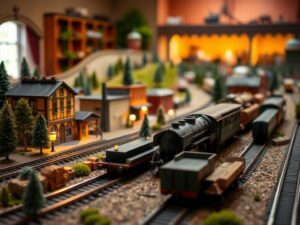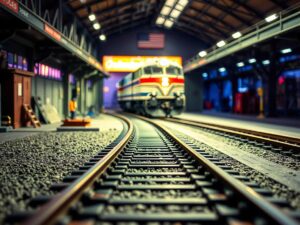How to Set Up Power for Your HO Scale Layout
How to Set Up Power for Your HO Scale Layout
How to Set Up Power for Your HO Scale Layout
Welcome aboard, fellow railfans! Today’s journey takes us deep into the heart of your model railroad â how to set up power for your HO scale layout. This might seem like technical jargon, but fear not, even seasoned vets often find themselves diving back into these concepts when adding new elements or upgrading their systems. Let’s break it down step-by-step, offering clear explanations and practical tips suitable for everyone from absolute beginners to experienced modelers.
The Foundations: Understanding Your Power Needs
Before we dive into the “how,” let’s clarify the “why.” Every locomotive and accessory on your layout requires electricity to run â the more you have, the more power you need. Consider these factors:
- Number of Trains: A simple single-line operation with a few locomotives requires less power than a sprawling network with multiple simultaneous trains.
- Types of Locomotives: Larger, diesel-electric locomotives demand more juice than small, passenger cars. Factor in sound and lighting systems for even greater power requirements.
- Track Length & Curves: While a short loop might be easily powered by a basic transformer, extensive layouts or complex curves might benefit from specialized power management solutions.
The Essentials: Choosing the Right Power Supply
The heart of your model railroad power system is the power supply, better known as a transformer. These regulate the electricity coming from your wall outlet to a safe voltage for your HO scale models (typically around 18 volts).
There are three primary types of transformers you might encounter:
- Basic DC Transformer: This affordable option offers constant voltage, suitable for small layouts with limited needs. Keep in mind that they lack advanced features like variable speed control or separate power outputs for different sections of your layout.
-
Digital Command System (DCC) Compatible Transformers: If you’re looking for the ultimate flexibility and realism, opt for a DCC-compatible transformer. This allows you to independently control each locomotiveâs speed, direction, and lighting through a handheld command station or computer interface. This setup is perfect for dynamic, multi-train operations.
-
Alternating Current (AC) to Direct Current (DC) Convertor: If your track wiring relies on AC power for some segments, an AC/DC converter will transform the current to ensure proper operation of DC-powered locomotives.
Laying the Tracks: Understanding Wiring Basics
Wiring your HO scale layout can seem daunting, but remember that Rome wasn’t built in a day! Follow these guidelines for safe and effective wiring:
- Plan Ahead: Before soldering anything together, create a detailed diagram of your track plan. This visual guide will be invaluable as you begin to connect wires to rails.
-
Isolate Track Sections: To maximize control over train movement and avoid short circuits, divide your layout into distinct sections powered by separate feeders from the transformer.
-
Wiring Techniques: Soldering is generally the most secure and reliable method for connecting wires to track, but use heat-shrink tubing or electrical tape to insulate connections properly and prevent shorts. Consider using a terminal block system for cleaner wiring management in complex setups.
- Grounding Matters: Ground your entire layout effectively! This protects both your equipment and you from potential electrical hazards. Use copper wire grounding to ensure that all metal components are connected to the ground bus, typically found on your transformer or a separate grounding terminal.
Essential Components for a Smooth Ride: Block Circuits
Block circuits are key for safe and realistic train operation. They allow you to control power flow to specific sections of track, ensuring locomotives only receive power when in their assigned “block.”
Here’s how block circuits work:
- Individual Power Drops: Each section of track on your layout receives its own power feed (wire connected from the transformer) known as a âfeederâ. This establishes a continuous circuit between the rails within that section.
- Insulators to Create Blocks: Strategically placed insulators separate different track sections, effectively breaking the continuous rail path.
Control System: A Vital Link: Depending on your chosen setup, block circuits work in conjunction with switches and detectors.
- Switches: These control the direction of locomotive movement, ensuring safe transitions between blocks.
- Detectors: Placed along track sections, these tiny electronic devices âsenseâ when a locomotive is within their range, triggering signals to the command station (DCC) or transformer to power the appropriate block.
Beginner-Friendly Wiring
Starting with a basic layout? Here’s a simple wiring approach:
-
One Loop: Connect a single continuous loop of track to your transformer using positive (+) and negative (-) wires. Remember, soldering offers a secure connection!
-
Add Branches Gradually: Once youâre comfortable, expand your layout by adding branches and smaller loops, each powered with a separate feeder connected to the transformer.
Power Distribution & Upgrades: Expanding Your Knowledge
As your HO scale layout grows more intricate, so will your power requirements:
- Dedicated Feeders for Different Sections: To enhance realism and control, consider creating dedicated feeders for specific sections of track (e.g., sidings, station platforms). This allows for greater operational flexibility.
- DCC Power Buses & Control System: Embrace the possibilities of DCC! Integrate power buses to deliver individual power to each section of your layout through a centralized command system.
Advanced Concepts & Troubleshooting
Delving into advanced concepts like “track powering,” “return paths,” and sophisticated DCC systems requires additional knowledge. There are numerous online resources, model railroad clubs, and publications dedicated to helping you explore these depths.
Don’t be afraid to experiment and troubleshoot! Itâs part of the journey in model railroading. When facing power-related issues, check your connections (both wire and track), examine your transformer settings, and consult with experienced modelers or online forums for guidance.
Wrapping Up: Enjoy the Ride!
Setting up power for your HO scale layout is a foundational step that brings life to your intricate creations. Remember to start small, expand gradually, and embrace the learning process. As you gain experience, youâll be able to tackle more complex systems and enjoy the thrill of bringing your railroad dreams to life.
Happy Railfanning!
Are there any specific aspects of HO scale layout power that you’d like me to delve into further?




